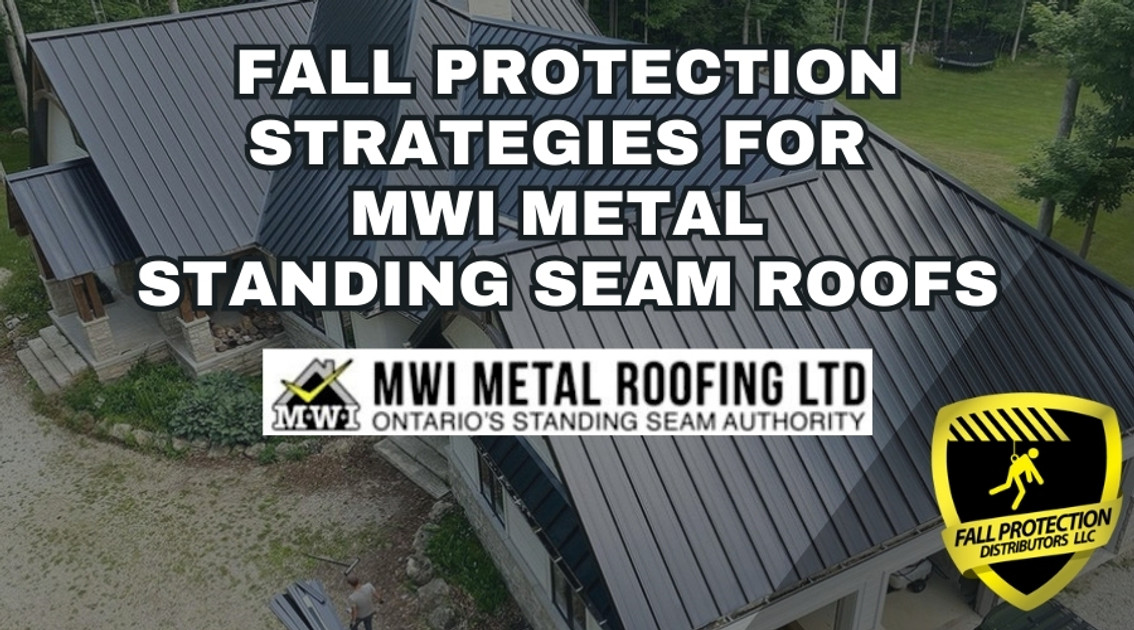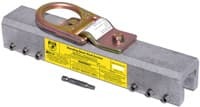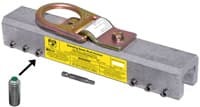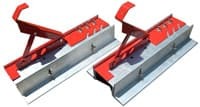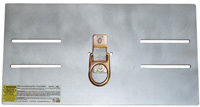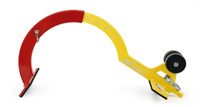Fall Protection Strategies for MWI Metal Roofing
Posted by Howie Scarboro - CEO Fall Protection Distributors, LLC on Aug 15th 2025
See the Roof Anchor Compatibility Chart for MWI Metal Roofing Standing Seam Panels.

Who Is MWI Metal Roofing?
MWI is one of Canada's best sources of on-site standing seam panel production.
If you spend enough time searching for metal roofs in Ontario, you'll hear the name MWI Metal Roofing. They consider standing seam roofs to be their specialty. However, they also produce metal slate, board-and-batten siding, and metal soffit.
The story begins in 1999, when founder Mike West was operating a small exterior renovation company in Orillia, Ontario. He wasn't afraid to get his hands dirty, tackling roofing, soffits, fascia, and siding for homes across the Muskoka region. Over the years, Mike and his crews earned a loyal following, especially among luxury cottage owners who wanted top-tier craftsmanship and a contractor they could trust. Word got around. MWI wasn't just good; they were meticulous.
By 2015, the demand for permanent metal roofing had surpassed that of all other roofing materials. Mike took a leap of faith and put it all on the line to invest in his first standing seam roll-former. That move changed everything. Suddenly, MWI could custom-make panels right on the job site. The fit was perfect, the turnaround was fast, and they could now supply other roofing contractors, rather than just handling their installs.
Fast-forward to 2021, and that one machine had turned into a fleet of ten roll-formers. Today, MWI runs the largest on-site "chop and drop" standing seam manufacturing operation in Ontario. They work with homeowners through their installation division and keep the roofing trade supplied with precision-cut panels. Their mobile manufacturing setup enables them to bring the factory to the project. This advantage allows them to roll out panels that meet exact specifications without the delays and damage risks associated with shipping from a fixed plant.
MWI has made standing seam an obsession. They refine their process year after year to deliver consistent, professional results. They've built their business on meeting timelines without cutting corners. That combination of experience, equipment, and an uncompromising standard has made them a name worth knowing in the world of metal roofing.
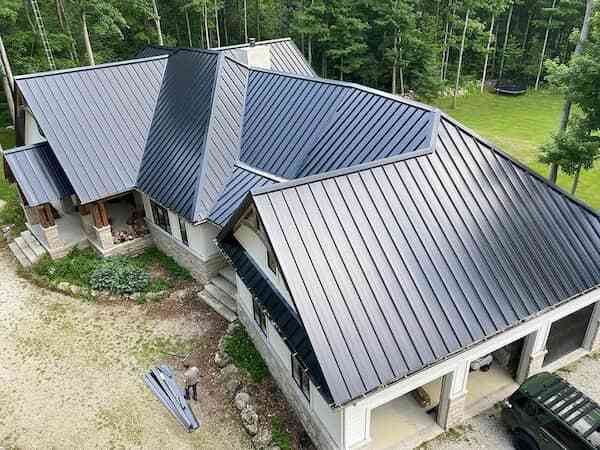
What Are Compatible Fall Protection Anchors Critical for MWI Standing Seam Roofs?
The safest and most efficient fall protection anchors for MWI standing seam roofs are those that attach without penetrating the panels, maintain the roof's integrity, and meet strict OSHA standards.
These roofs are an investment, and no contractor wants to be the one who leaves behind drilled holes or distorted seams that can void a warranty. The right anchor not only keeps the worker safe but also preserves the roof for decades to come.
For 22 and 24-gauge steel panels, the Standing Seam Roof Anchor (SSRA1) offers the best option. This clamp-style anchor locks directly to the seam with stainless steel set screws, creating a solid tie-off point without any penetration. It is made from high-strength aluminum, making it both lightweight and strong enough to meet OSHA fall arrest requirements. Once in place, it serves as the base for additional safety gear, including the SSRA2 Adjustable Roof Jack Adapters for staging 10-foot wooden walkboards and the SSRA3 Anchor Plates for setting up temporary 100-foot horizontal lifelines.
When the panel material is aluminum, copper, zinc, or a lighter-gauge steel, the Ridge Pro Steep Assist is often the better option. This peak-mounted anchor works on slopes from 6/12 to 12/12 and keeps the worker tied off while they move from the ladder to the roof and back. It's especially valuable on slick or steep surfaces where even experienced roofers need extra security before setting their primary anchor points.
The takeaway is simple. MWI roofs require non-penetrating anchors that protect the seam and panel finish while still delivering OSHA-compliant safety. Using seam-mounted anchors, such as the SSRA1, on compatible gauges, or switching to the Ridge Pro Steep Assist where needed, is a smart move for the building owner, contractor, and workers.
1.5-Inch Mechanical Panels

The 1.5-inch Mechanical Lock panel from MWI Metal Roofing & Siding is a high-performance standing seam option built for durability, weather resistance, and a long service life in even the most challenging Ontario conditions.
This profile combines on-site manufacturing precision with exceptional material choices, making it one of the most reliable options for both residential and commercial roofing. See the Roof Anchor Compatibility Chart for MWI Metal Roofing 1.5-Inch Mechanical Standing Seam Panels.
This panel is available in a range of premium materials, including G90 galvanized steel, Galvalume, aluminum, copper, and zinc. Contractors and building owners can also choose between SMP and PVDF matte or low-gloss finishes, with PVDF offering advanced resistance to fading, chalking, and surface damage. MWI offers these panels in widths ranging from 12 to 24 inches, with a seam height of 1 15/32 inches. Crews cut lengths to exact project specifications using MWI's on-site roll forming process. This approach minimizes transport damage, costly errors, and delivery surcharges.
Two gauges are available: 24-gauge steel for maximum strength and walkability, and 26-gauge steel for lighter-weight applications. The panel installs directly to the roof deck and can handle slopes as low as 0.5:12 without compromising watertightness. A concealed fastener system keeps the surface free from visible screws or penetrations, improving aesthetics while eliminating common leak points. This profile's mechanical lock seam is folded and crimped in place with specialized tools, creating a permanent seal that excels in high-wind, heavy-snow, and low-slope scenarios.
MWI's PVDF-coated versions meet rigorous ASTM standards for coating thickness, gloss retention, humidity resistance, salt spray performance, acid resistance, and flexibility. That means these panels not only look good when installed, but they also stay that way for decades with minimal maintenance. The finish resists graffiti, holds color exceptionally well, and maintains structural integrity under extreme environmental stress.
Fall Protection For 1.5 Inch Mechanical Panels
The SSRA1 seam anchors create a non-penetrating, OSHA-compliant tie-off point on 24-gauge steel seams, serving as the base for adapter plates.
The one-piece extruded body, made from solid 6061-T6 aluminum, features stainless or nylon-tipped set screws that clamp securely to the standing seam without requiring drilling. That clamping action preserves weathertightness and prevents seam distortion when you follow torque guidelines. Crews like it because they can install it in two minutes and remove it in one.
The SSRA2 Adjustable Roof Jack adapters expand the SSRA1 from a single tie-off point into a stable work platform by mounting on top of the SSRA1 anchors. They are seam-height and panel-pitch adjustable, with padded side legs to provide a stable mount for the walkboard. Once in place, the adapter accepts 10-foot wooden walkboards, providing crews with stable working surfaces on steeper roofs.
The SSRA3 Anchor Plates are another popular adapter plate for the SSRA system. The SSRA3 converts two SSRA1 anchors into a horizontal lifeline system, allowing two users to stay tied off for maximum mobility. Our 100-foot temporary lifeline kit includes the 100-foot lifeline, four SSRA1 seam anchors, and two SSRA3 Anchor Plates. The SSRA HLL kit is renowned for providing maximum worker mobility without penetrating the roof system.
Our industry-exclusive 120-foot Super Anchor Permanent Horizontal Lifeline kit provides everything needed for a dependable anchorage for wide roof areas. The system uses non-penetrating seam clamps, aluminum base plates with 5-inch riser posts, and 120 feet of galvanized steel cable. This kit is an excellent option for buildings that require routine maintenance and worker access.
The Ridge Pro Steep Assist protects workers on lighter 26-gauge steel and on alternative materials where seam clamping is not suitable, providing a fast, non-penetrating ridge anchor for access and work positioning. Think of it as a ladder hook, but instead of a bulky ladder, it mounts on a 16-foot-long extension pole. The device locks over the ridge, allowing a 100% worker tie-off from the ladder to the roof and back. It works on slopes from 6/12 to 12/12. It pairs well with a harness, vertical lifeline, rope grab, and energy absorber for a professional setup. The aluminum body and stainless connection point keep weight down and durability up. Crews like that they can place it quickly, clip in, and then relocate it as the work advances. On slick finishes or in cold weather, the early tie-off before the first step onto metal is the difference between confidence and caution.
The right standing seam anchor choice depends on the panel gauge.
Match the anchor to the panel to avoid accidents and injuries. Use SSRA1, SSRA2, SSRA3, the 100-foot temporary lifeline, and the 120-foot permanent lifeline on the 24-gauge steel version of this MWI profile. Use the Ridge Pro for the 26-gauge version and for aluminum, copper, or zinc variations where seam clamping does not work. If a project involves curved panels or unusual conditions, bring in a trained safety professional to inspect and engineer the right approach before staging any hardware.
Final Checks That Keep Everyone Safe
Maintain installation torque within the specified range, confirm clearances, and document all inspections. Perform a test fit before the workday to verify the proper anchor fit with the panel.
1.5-Inch Nailstrip Snaplock Panels

The 1.5-inch Nailstrip Snaplock panel from MWI Metal Roofing delivers long-term performance, a clean architectural look, and the convenience of concealed fastening.
This profile is available in a variety of metals and finishes, and crews roll-form each panel on-site to the exact job length. MWI can manufacture these panels in G90 galvanized steel, Galvalume, aluminum, copper, or zinc. Finishes include SMP and PVDF in matte or low-gloss options, with PVDF providing enhanced resistance to fading, chalking, and environmental wear. Panel widths range from 12 to 24 inches. The seam height measures 1-15/32 inches, and crews cut each panel to the exact project length on site. See the Roof Anchor Compatibility Chart for MWI Metal Roofing 1.5-Inch Nailstrip Snaplock Standing Seam Panels.
MWI offers two gauges. The 24-gauge steel provides maximum strength and walkability, while the 26-gauge steel is suitable for light-duty applications. Panels are installed over a solid deck using a concealed clip system, resulting in a streamlined appearance and eliminating the need for exposed fasteners. The minimum roof pitch for installation is 2/12, and the snaplock engagement method allows the seam to clip securely over the adjoining panel without mechanical seaming.
Like all MWI panels, these meet strict ASTM standards for coating thickness, gloss retention, humidity resistance, salt spray performance, and flexibility. That means they not only perform in severe weather but also maintain their appearance for decades with minimal upkeep.
Fall Protection For 1.5-Inch Nailstrip Snaplock Panels
Fall protection compatibility for this panel depends on the gauge, material, and the method of seam formation and installation.
Snaplock seams can vary in width and engagement depending on installer technique and clip spacing. Some will accept the SSRA clamp profile perfectly, while others will not. Because of this, a test fit is always recommended before the day of work to confirm the correct anchor grip and torque.
On 24-gauge steel panels that pass a proper fitment check, all SSRA products are suitable. The SSRA1 Standing Seam Roof Anchor clamps directly to the seam without penetrating, creating an OSHA-compliant tie-off point. It serves as the foundation for additional gear. The SSRA2 Adjustable Roof Jack Adapters mount on top of the SSRA1 to hold 10-foot wooden walkboards, giving crews a stable platform on steep or slick panels.
The SSRA3 Anchor Plates also mount on top of the SSRA1, turning two anchors into a temporary horizontal lifeline system. Our 100-foot temporary HLL kit includes the 100-foot rope lifeline, two SSRA3 Anchor Plates, and four SSRA1 Seam Anchors.
For roofs that require routine maintenance and inspections, the 120-foot Super Anchor permanent horizontal lifeline kit offers non-penetrating bases, 120 feet of galvanized steel cable, and 5-inch riser posts.
When the roof is aluminum, copper, zinc, or lighter 26-gauge steel, do not use seam-mounted anchors. In these cases, the Ridge Pro Steep Assist is the better option. This peak-mounted device operates on slopes ranging from 6/12 to 12/12, enabling a worker to tie off fully before stepping onto the panel surface. The aluminum frame and stainless steel connection point keep weight low and strength high. Workers hook it over the roof peak and relocate it as work progresses. On slick finishes, frosty mornings, or steep slopes, this early tie-off prevents serious incidents.
By selecting the right system based on gauge, seam fit, and material, crews can work on MWI's Nailstrip Snaplock roofs without compromising safety or the roof's long-term performance. The combination of SSRA products on verified 24-gauge seams, or Ridge Pro on lighter or softer materials, covers the full range of scenarios these panels present.
Metal Roof Anchor Panel Compatibility For MWI Metal Roofing
| 1.5-Inch Mechanical Panels 24 ga. |
1.5-Inch Nailstrip Snaplock Panels 24 ga. |
|
|---|---|---|
| YES | YES | |
| YES | YES | |
| YES | YES | |
| YES | YES | |
| YES | YES |
Contact Us For More Information
For further details on roofing solutions and fall protection systems, contact us at 863-703-4522 or www.StandingSeamRoofAnchor.com. Let's work together to make your roofing projects safe, beautiful, and built to last. For more safety tips, refer to OSHA's 48-page Fall Protection Manual. Once you have determined the most suitable anchors for your roof system, download our free Anchor Inspection Form.
Safety Tips For Standing Seam Roofs
Use Specialized Anchor Systems for Standing Seam Roofs
Standing seam roofs demand anchors that protect both the worker and the roof system. Standard screw-down anchors can compromise the panel by causing leaks, corrosion, and warranty issues. Instead, use OSHA-compliant seam-mounted anchors that clamp directly onto the seam without drilling. These anchors provide a secure tie-off point while preserving the panel's structural integrity and weathertightness. For MWI's 24-gauge compatible panels, products like the SSRA1, paired with SSRA2 walkboard adapters or SSRA3 lifeline plates, create a versatile and non-penetrating safety system designed for standing seam conditions.
Install Permanent Roof Anchor Systems
When a building requires repeated access for inspections, HVAC service, or solar panel maintenance, permanent anchors make the process fast and efficient. These fixed tie-off points are engineered for long-term use, allowing crews to clip in immediately upon accessing the roof. On large-scale commercial or industrial MWI installations, permanent anchors reduce setup time, lower labor costs, and help maintain full OSHA compliance without relying on temporary solutions every visit.
Ensure Proper Footwear for Stability
A stable stance is the foundation of safe work on a metal roof. The proper boots, with deep-tread, slip-resistant soles, provide grip on smooth standing seam panels, even on steeper slopes. Good ankle support helps maintain balance when carrying tools or working near the edge of a surface. Without a secure footing, even the best anchors and harnesses can't fully protect a worker from a fall. Footwear should be a non-negotiable part of every MWI jobsite safety checklist.
Promote a Culture of Safety
Proper jobsite safety extends beyond gear—it begins with the right mindset. Crews who treat safety as part of their routine tasks naturally reduce risks. Kick off each shift with quick safety talks, review hazard zones before starting work, and encourage open dialogue when someone spots a problem. On MWI projects, where crews must protect both panel integrity and worker safety, a strong safety culture ensures that everyone is watching out for each other.
Encourage the Use of Trauma Straps
Harnesses save lives during a fall, but minutes spent suspended can cause suspension trauma if the harness cuts off circulation. Trauma straps attach to a harness and allow a fallen worker to stand in their harness loops, relieving pressure while waiting for rescue. These straps are a low-cost, high-value addition to any roofing safety kit. They can mean the difference between a save and a serious injury.
Set Up Protective Guardrail Barriers for Work Zones
Guardrails provide continuous, passive fall protection that doesn't rely on a worker's attention or action. When large crews are moving in multiple directions, guardrails create clear, physical boundaries near edges, skylights, or other openings. Their presence lets crews focus on the task at hand without worrying about getting too close to a fall hazard.
Develop OSHA-Compliant Safety Plans
A detailed, written safety plan ensures that everyone on site understands their role in maintaining a safe and accident-free project environment. For MWI installations, this includes identifying seam-compatible anchor systems, mapping out tie-off points, outlining rescue procedures, and reviewing site-specific hazards. A documented plan not only keeps the crew safe but also serves as proof of compliance during inspections.
Consult Experts for Curved Metal Panels
Curved or radius standing seam roofs create unique challenges for fall protection. Standard anchors may not grip properly and could cause the panel to distort if installed incorrectly. Before working on curved profiles, have a trained safety professional evaluate the surface and design a custom fall protection system to ensure safety. This approach protects both the worker and the roof's finish while keeping the project compliant.
Equip Workers with High-Quality Safety Gear
The effectiveness of a fall protection plan is only as good as the gear used. Harnesses, lanyards, SRLs, and connectors must meet or exceed OSHA and ANSI standards. On MWI roofs, lightweight, padded, and adjustable harnesses enhance comfort, directly improving compliance. Workers are more likely to wear their gear consistently when it fits well and supports freedom of movement. As of the 2025 OSHA update, safety managers are now fully responsible for ensuring that all workers wear properly fitting personal protective equipment.
Prioritize Ladder Safety Training
Falls don't just happen on the roof—many start on the ladder. Every MWI crew should know how to inspect ladders for defects, set them on level ground, and maintain three points of contact when climbing. Applying the 4-to-1 rule for ladder angle placement minimizes the risk of slipping. It ensures a stable base before anyone even reaches the standing seam surface.
Disclaimer
The views, recommendations, and information presented in this blog are solely those of the author and do not necessarily reflect the opinions or positions of the featured panel manufacturer, its brands, subsidiaries, or parent companies. Customers are strongly encouraged to contact the roof panel manufacturer directly for inquiries regarding fall protection compatibility with their products and to address any potential warranty issues that may arise after installing our products.

